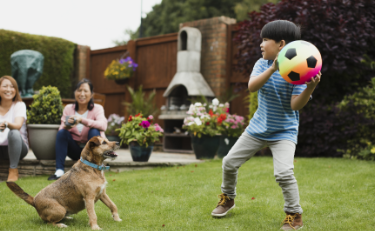Pavers & Natural Stone
NEW INSTALLATION
Concrete, clay, and natural stone pavers (bluestone, sandstone, limestone) require minimal maintenance to provide you with years of enjoyment of your patio, sidewalk or driveway. Within the first month after installation, you may notice some sand residue on the paver surface or a small amount of settling in the paver joints. This is normal. You can correct settling in the joints by adding some of the same jointing sand used on the original installation (most commonly polymeric sand or gator dust). This could take more than one application but isn’t typical.
NOTE: With joints no larger than one inch, it’s typical to use polymeric sand. Another type of polymeric jointing sand is gator dust, used with joints one inch or larger. Both kinds of jointing sand require a very specific application process. If you don’t follow the process, you may damage the pavers. Also, any type of jointing sand requires some maintenance after installation due to Ohio’s freeze/thaw cycle.

SNOW REMOVAL AND DE-ICING
To remove snow from your pavers, use a plastic shovel or plastic blade protectors on your snow plow or blower. Please note: Any de-icing product has the potential to damage paver material. However, if you do plan to de-ice your pavers, two types of products are recommended:
- Sodium Chloride (NaCl) – for use in temperatures as low as 20◦ F
- Calcium Chloride (CaCl2) – for use in temperatures between 20◦ F to -2◦ F
Other recommendations when using de-icing products:
- Use the minimum amount to melt the snow and ice.
- Sweep up and remove excess de-icer.
- Avoid rock salt or magnesium-based products as they are very aggressive and will cause damage to hardscape surfaces.
ROUTINE MAINTENANCE & CLEANING
Concrete and clay pavers are porous and, along with natural stone, can stain and/or weather with age. It’s recommended to sweep routinely, especially in high traffic areas. For a deeper clean, carefully use a pressure washer.
There are a few general guidelines when pressure washing your patio. Do not use the high-power nozzle setting attachment with your pressure washer as this will etch the surface. Always keep the nozzle at an angle and at least 12 inches away from the surface, using the fan nozzle setting attachment. Be gentle around joints so as not to dislodge too much jointing sand.
Cleaning solutions are another option for cleaning your patio. Check your local retail store for general cleaning solutions and specialized ones designed for oil and grease or efflorescence. You can also use a mixture of 20 percent dish soap to 80 percent water, applied with a soft bristle brush. Always be gentle with the jointing sand. Do not use a wire brush as pieces of wire can become dislodged, promoting rust and/or scratching the paver surface.
With either process, you may need to re-apply jointing sand once the surface and joints are completely dry. Please note: Cleanliness and color rejuvenation are not guaranteed through any process. The age of your product can affect the color.

SEALING
For most paver and natural stone products, it’s not recommended to seal the surface. You can seal pre-cast manufactured pavers such as Unilock to enhance or deepen the color, but this is not necessary. Please note: Once you choose to seal the pavers, you’ll need to reapply the sealer following the manufacturer’s recommendations.
WEED PREVENTION & TREATMENT
Polymeric sand between paver joints is the best way to prevent weed growth. However, not all dry laid pavers have polymeric sand joints. In this instance, a pre- or post-emergent herbicide is recommended for weed control. Test a small area of the paver to ensure it doesn’t stain and always follow the manufacturer’s instructions.
Let Rice’s Estate Landscape Management handle your lawn and landscape care. Contact us today to get started.




 5-Star Houzz Reviews
5-Star Houzz Reviews
 40+ Ohio Landscape Association Awards
40+ Ohio Landscape Association Awards
 80+ Years of Service
80+ Years of Service
 ONLA Award Recipient
ONLA Award Recipient
 NALP Proud Member
NALP Proud Member